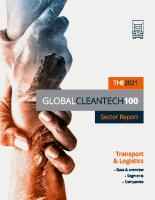Smart Cities and Curb Management: Innovating for Success
Curb spaces have historically been a source of parking revenue for cities, but the COVID-19 pandemic has accelerated the need for regulating a variety of other use cases which most cities are not yet equipped for. From an increase in food and parcel deliveries to outdoor streateries, the pandemic has changed the way cities are looking to organize and monetize their curb space.
Curb pricing models have changed very little since they were originally introduced in cities decades ago. Metered parking is geared towards personal vehicles and does not allow many options for commercial operators. As a result, many either park illegally or circle the block multiple times while waiting for a spot. Cities also rely on legacy signage, resulting in driver confusion as to which sign applies where, creating an inefficient parking and ticketing system.
Several innovators across the US and Europe have recognized the need for digital solutions at the curb to help cities take advantage of new use cases and increase allotted space for outdoor dining and parklets (small areas of green space along a sidewalk where parking space used to be). These solutions offer several environmental and economic benefits, including:
- Reduced traffic and need for circling and idling, which create concentrated emissions where people live, work, eat, and shop
- Increased variety of use cases, creating more sources of revenue for cities
- Increased efficacy of ticketing through parking reservations or automated enforcement
Attractiveness
The global parking management market was estimated at $3.8 billion in 2020 and is expected to grow to $5.4 billion by 2025. Innovators are working on curb solutions in the context of parking management, while computer vision startups are also applying their technology to automate enforcement of the curb. These automated solutions are similar to technologies falling under the global road safety market, which includes traffic light, speed, bus lane, and section enforcement. This market is also expected to experience a growth period in the coming years, up to $6.3 billion by 2028.
Inefficiencies in the current parking structure causes an increase in urban traffic and costs cities billions of dollars each year. For example, the annual traffic cost to economies in New York and the UK totaled $20 billion and $9.7 billion respectively, due to productivity loss and other excess costs. Traffic and idling cost the environment as well – six billion gallons of fuel is wasted annually in the US alone from idling in heavy and light-duty vehicles. Personal vehicles account for half of the total, resulting in 30 million tons of CO2 generated each year. Fortunately, smart parking investment is estimated to reach $1 billion in 2025, up from $460 million in 2021.
As we move into a digitized future, curbsides will only become more congested. In California, lawmakers are trying to pass Assembly Bill 1401, which will eliminate parking requirements for new buildings near public transit and walkable neighborhoods. Parking requirements have long driven up the cost of housing, and residents end up paying for this cost whether they drive a car or not. This bill would reduce the amount of available parking spaces in cities, so the parking spaces that do exist will have to be used more efficiently.
Business Models
Most current pricing models of the curb are based on cities’ fixed assets, such as street signs displaying parking rules. However, most of these assets are rarely cataloged digitally by cities and multiple signs on the same block can create driver confusion. Curb management innovators know accessibility of data, such as curb availability, demand, and common use cases, is the key to accelerating curb digitization. Below are some key ways innovators are gathering mobility data and providing curb solutions across the value chain.
- Mobile and Fixed Cameras

In recent years, cities have implemented fixed traffic light cameras to automate traffic violations and innovators such as Automotus and curbFlow are using similar hardware to automate ticketing at the curb, eliminating the need for payment apps or kiosks. Hayden AI is another computer vision company, but they are using mobile cameras, mounted on city vehicles like buses, to automate curb and bus lane violations. For automated enforcement to succeed, cities will need to enact legislation supporting automated enforcement of parking spaces, as only some have adopted similar legislation for camera-captured traffic violations.
- Vehicle data, in-road sensors and geofences

CivicSmart, Allvision and Numina are providing solutions through vehicle location data, which allows users to see available loading bays and book spots close to their destination through mobile apps and booking platforms. Grid Smarter Cities uses similar geofence technology that can be integrated with in-road sensors to automate enforcement and provide fleet analytics. This solution allows for dynamic booking of spaces, thereby helping speed up deliveries.
- Telecommunications Data
Mobility insights innovator, Teralytics, uses telecommunication data from a combination of sources to process mobility data into trips and create origin destination matrices. Current government sources, like census data, are not always up to date, so telco data allows for more complete insights. While Teralytics technology focuses on total mobility demand, it also shows mobility patterns and trip attributes which can be very useful when modeling curb solutions.
The companies mentioned above have emerged over the past year with various pilot projects and early-stage investments:
- February 2020: Teralytics, developer of mobility insights to inform city planning and operations, partnered with Bosch, HERE Technologies, Stantec, SpotHero, and Carrier Direct in a curbside management project in Chicago, launched by City Tech Collaborative. The project modeled demand and value for different use cases at the curb.
- November 2020: Grid Smarter Cities, provider of mobility and curb space solutions using virtual loading zones, joined HS2’s Innovation Accelerator program to help manage commercial freight movement and activity in urban areas. They also received a grant of $700K from Innovate UK in November of 2019 to ease congestion in the Croydon area of London by managing movement and deliveries from construction vehicles.
- March 2021: Automotus, provider of curb analytics and automated enforcement through a network of intelligent fixed cameras, raised $1.2 million in seed funding led by Techstars Ventures. Automotus plans to raise a $12 million Series A round later this year. They also announced a pilot project with the City of Santa Monica and Los Angeles Cleantech Incubator to monitor a zero-emissions delivery zone.
- April 2021: Hayden AI, provider of an autonomous curb enforcement platform using mobile perception systems, partnered with Conduent to automate enforcement in bus lanes. This partnership will combine Hayden’s mobile cameras and computer vision software with Conduent’s ticketing solutions for curb management to enforce illegally parked vehicles and other traffic violations in bus lanes. Hayden AI plans to raise a Series A round later this year, after having raised $9.5 million in seed funding over the last year to accelerate product development. Their latest round was led by BootstrapLabs with participation from Autotech Ventures, UC Berkeley’s Strawberry Creek Ventures, Modern Venture Partners, and e.Republic Ventures.
Competition
Many incumbent parking management and mobility mapping platforms are working on solutions in this space. As previously stated, Conduent and HERE Technologies, are working with new innovation to develop curb management solutions. Automotive manufacturers and shared mobility operators are following suit, as Ford, Uber, and Lyft announced a partnership in 2018 to use the SharedStreets data platform, a software platform enabling public-private collaboration of transport data, to manage curb space and reduce congestion in an effort to reduce emissions.
Other communications corporates, such as Cox Communications, are choosing to launch their own curb management platform. Cox Communications introduced their Cox2M curb management solution in April for a pilot project with the city of Las Vegas. The purpose of the pilot is to help manage Las Vegas’s downtown congestion by implementing curbside kiosks with cameras, which detect vehicles and automate alerts for drivers when they’ve been on the curb for too long.
Keep an Eye Out for…
Most curbside solutions currently rely on mobile apps to communicate curb data to users and allow for booking and payment on the app. However, innovators in this space recognize having another parking app is just a barrier to adoption for most cities and users. Automotus, Grid Smarter Cities, and Hayden AI, are all moving towards using APIs in place of mobile applications to make their data available for fleets and other users. Moving away from mobile applications will allow for quicker adoption of curb solutions in cities and will allow more drivers to reap the benefits of curb innovation.
Over the next several years, we expect to see more cities moving towards digital curb solutions. To get there, they will need to support legislation that enables dynamic curb use, such as automated ticketing, and flexible pricing models and use cases. Once hardware solutions are scaled up, the economic benefits of curb technology will be better understood by cities, but the biggest hurdle for innovators now is understanding how government operates to accelerate adoption of curb solutions.
Already Driving an Electric Car?

The changes won’t stop with electric cars. Get the Transportation & Logistics Sector Report for more insight into:
- Companies dedicated to the transformation ahead.
- Technologies with the potential to change everything.
- Market trends investors should be aware of.


